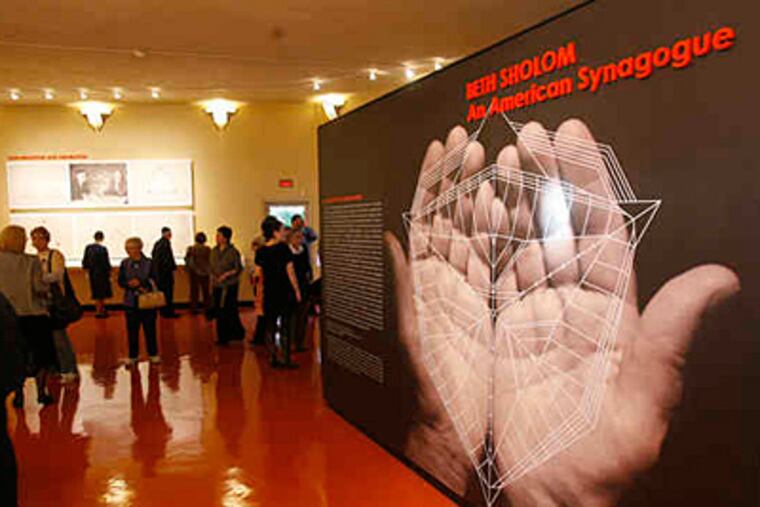Frank Lloyd Wright-designed synagogue adds visitor center
Architect Frank Lloyd Wright spent the final months before his death in 1959, at the improbable age of 91, wresting two of his greatest buildings to completion.

Architect Frank Lloyd Wright spent the final months before his death in 1959, at the improbable age of 91, wresting two of his greatest buildings to completion.
One, New York's Guggenheim Museum, has been basking all this year in lavish birthday celebrations. But the other, Elkins Park's Beth Sholom Synagogue, is only beginning to receive the attention it deserves.
The modernist glass pyramid on Old York Road marked its 50th anniversary yesterday with the opening of a small visitor center nestled into one of its Wright-designed reception rooms. That modest amenity, the congregation hopes, will begin to spread the building's reputation further afield, and eventually lead to a renovation as extensive as the one just completed at the Guggenheim.
Unlike its glamorous cousin on Fifth Avenue, the suburban synagogue hasn't spent much time burnishing its image internationally. The congregation has been too busy using Wright's light-saturated sanctuary and running religious programs. But as Wright's historical stature has grown, so has the recognition that Beth Sholom is more than just another synagogue, said Harvey Friedrich, the congregation's executive director.
The building was commissioned in the mid-'50s just as large numbers of urban Jews were decamping for the suburbs, including those from Beth Sholom's original North Broad Street home. Wright's design provided a template for what a modern American synagogue could be, in much the same way that his Guggenheim offered an alternative to the classical museum form.
Architectural pilgrims have always knocked on the synagogue's doors asking for glimpses of its soaring interior. But now, instead of having to buttonhole a busy staff person to unlock the sanctuary, Friedrich said, visitors will be able to take scheduled tours and peruse videos and documents telling the story of Beth Sholom's creation. They can even purchase souvenirs in a tiny gift shop, inserted into a former kitchen by the project architects, Philadelphia's VSBA.
For all that, Friedrich took pains to stress that the new center "is not a museum." That's by design. "We wanted to make sure that everyone concerned understands that this is a living congregation."
That was easy to see yesterday as several hundred people took their places in the sanctuary's padded, and surprisingly comfortable, Wright-designed chairs to hear Paul Goldberger, the New Yorker magazine's architecture critic, recount the synagogue's storied history.
He described how Wright had steadfastly refused all synagogue commissions during his long career, even though many of his best clients were Jewish.
Beth Sholom's rabbi, Mortimer J. Cohen, was finally able to break down the famous architect's resistance by appealing to his sense of history. He told Wright that he believed he could reinvent the traditional synagogue, and come up with something both modern and uniquely American.
Wright accepted the challenge, and Beth Sholom became his only synagogue design. It opened for the High Holidays in September 1959, five months after Wright's death.
After 50 years of heavy use, Wright's design appears remarkably intact. All of his original Mayan-inspired details are in place, including the carved Torah ark, V-shaped sconces, and the exuberant, geometric aluminum details that divide the Plexiglas roof panes.
"It's still in pretty good shape," Friedrich said, "although it could use some TLC." Occasionally, the roof leaks. Some of the corrugated glass panes - similar to those used on home patios in the '50s - need cleaning.
But the soaring six-sided building, which combines the steeple and sanctuary into one form, is an unmistakable local landmark. It has been variously compared to Mount Sinai, a glowing ark, and a giant fish.
Yet as visitors make their way from the compressed, low-ceilinged entry into the expansive sanctuary, they are invariably struck by its spiritual power, Goldberger said.
"Wright wants us to think that because the building is translucent that it is clearer and more rational than it is," he said. "It is so much more than that."
The exhibits, designed by New York's Picture Projects, help explain how the building is put together. The project, which cost $500,000, is partly a testament to Wright's growing popularity, and comes on the heels of a new visitor center for one of his remarkable houses in Buffalo.